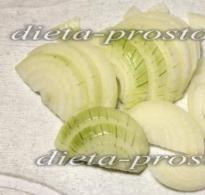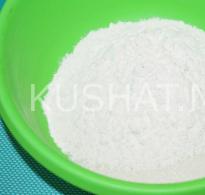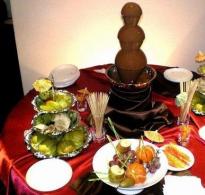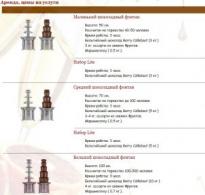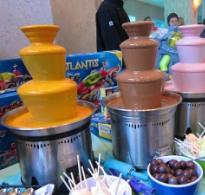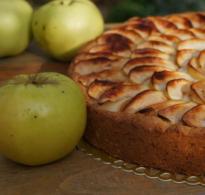Avar khinkali. Features of cooking Avar khinkal
Khinkal in Avar is often confused with another dish consonant with it, “Georgian khinkali”. A luxurious treat consists of fragrant boiled meat, fluffy dough cakes, sauce and rich meat broth. The dish is served in beautiful dishes, decorated with lots of fresh herbs.
How to cook Avar khinkal
- The preparation of this dish consists of the following processes:
- Boiling meat - lamb or young beef.
- Kneading dough and forming cakes. The dough can be cut into squares or diamonds.
- Sauce preparation. It goes best with tortillas and meat tomato, white, creamy, cheese sauces.
By combining all the ingredients together, you will get not just an interesting dish, but a full, mouth-watering dinner or lunch. A step-by-step recipe for Avar khinkal contains all the necessary cooking recommendations. How to use an outlandish dish? They eat it exclusively with their hands. First, they take a cake, dip it in the sauce and bite off. Then they drink it with hot broth and treat themselves to boiled, spicy meat.
Khinkal dough
Every Dagestan hostess knows how to cook khinkal. The secret of lush and soft cakes lies in the method of preparation. The dough for the Avar khinkal will be ideal if you strictly follow the chosen step-by-step recipe. Remember, it should not be rich, do not overdo it in adding eggs, butter, sour cream. It is traditional to use a fermented milk product - matsoni, to which soda is added to make the dough fluffy. In the absence of a traditional Avar drink, you can use yogurt, fermented baked milk, kefir.

Sauce for Avar khinkal
Traditional sauces for Avar khinkal: tomato or white. In order to make the first, you need to stew chopped juicy tomatoes in a pan (or use tomato paste), add spices, garlic, salt. To please your family with white sauce, you just need to mix sour cream or natural yogurt with mayonnaise, garlic and spices. The addition of a large number of various finely chopped greens is welcome.
How many minutes to cook Avar khinkal
You do not need to cook Avar khinkal for a long time, just 3-4 minutes, and it is ready to eat. The duration of the heat treatment will depend on the thickness of the slices you will cut the dough. After you have placed them in boiling water, wait for it to boil. Mix the blanks well and reduce the fire. As soon as the water boils again, turn off the fire and remove the products with a slotted spoon.
Avar khinkal on kefir
- Cooking time: 1 hour.
- Calorie content of the dish: 155 kcal.
- Cuisine: Caucasian.
Making Avar khinkal on kefir at home is very simple. It is important that the dough is tender and soft, but not torn. Small cakes should be boiled in a wide, large saucepan so that the products do not stick together. When preparing white sauce, instead of kefir, you can use low-fat sour cream or yogurt. When preparing tomato sauce, it is better to choose the juiciest tomatoes so that its taste is rich and bright.
Ingredients:
- flour - 950-1050 g;
- salt - 0.5 tsp;
- baking soda - 1 teaspoon;
- kefir - 2 cups;
- lamb - 850-950 g;
- garlic - 4 teeth;
- butter - 125 g;
- tomatoes - 1 kg;
- cilantro - 55 g;
- onions - 1 pc.;
- egg - 1 pc.
Cooking method:
- Put a whole onion into the water, boil the meat in salted water with the addition of dill stalks for about 40 minutes. Take the lamb out into a bowl.
- Pour the flour in a slide, make a hole in the center. Pour in salt and soda. Add egg and kefir. Knead the dough and leave for 15 minutes. Knead it, divide into 3 parts. Form into sausages and press lightly. Cut into 2-3 cm pieces.
- Place the cakes in the broth. Bring to a boil, then reduce the heat, remove the lid. Boil for another 4 minutes, remove from the pan.
- Make tomato sauce. Finely chop the tomatoes, salt and pepper. Simmer in a skillet for about 10 minutes. Add chopped garlic, salt, sugar.
- Put the chopped lamb and tortillas on a plate. Serve with sauce and chopped parsley.

Avar khinkal with yeast
- Cooking time: 55 minutes.
- Servings: 4 persons.
- Calorie content of the dish: 148 kcal.
- Purpose: for lunch, for dinner.
- Cuisine: Caucasian.
- Difficulty of preparation: medium.
Avar khinkal with yeast is not a traditional recipe, but many housewives fell in love with it. Choose young lamb, preferably the flesh of the kidney part. Dry yeast is important to add to warm, not hot milk or water, otherwise the dough will not rise. You need to cook khinkal in small portions. Pierce the finished hot pieces with a wooden skewer so that they are airy and do not lose their shape.
Ingredients:
- lamb - 700-850 grams;
- flour - 750 g;
- dry yeast - 20 g;
- vegetable oil - 35 ml;
- milk - 450 ml;
- potatoes - 550 g;
- garlic - 5 cloves;
- sour cream - 75 g;
- mayonnaise - 50 ml;
- salt - 8 g;
- pepper - 2 g.
Cooking method:
- Boil the meat in salted water.
- Add dry yeast to flour, mix. Pour in warm milk, butter and salt. Knead the dough, leave to rise in a warm place.
- Prepare the white sauce. To do this, mix sour cream, chopped garlic and a little mayonnaise. We salt it, we pepper it. Mix thoroughly.
- We divide the dough into two parts. We roll each into a cake 3-4 millimeters thick. Lubricate the surface with butter, then roll into a roll. Cut into small pieces 3 cm in size. Boil in broth for 5-6 minutes.
- Boil the peeled potatoes until tender.
- Serve boiled potatoes, khinkal and white sauce on a dish. If desired, you can decorate with greenery.

Avar khinkal for a couple
- Cooking time: 1 hour.
- Servings: 4 persons.
- Calorie content of the dish: 222 kcal.
- Purpose: for lunch, for dinner.
- Cuisine: Caucasian.
- Difficulty of preparation: medium.
Steamed Avar khinkal is a very tasty and satisfying meal. It diversifies the daily diet and will look good on the festive table. The abundance of fresh herbs will give the dish an aroma and an attractive appearance. Khinkal must be served hot so that it does not lose its qualities. A step-by-step recipe with a photo will help you create this culinary masterpiece.
Ingredients:
- beef - 750 g;
- carrots - 2 pcs.;
- onions - 2 pcs.;
- coriander grains - 5 g;
- basil - a bunch;
- dill - a bunch;
- vegetable oil - 85 ml;
- salt - 10 g;
- flour - 0.5 kg;
- milk - 250 g;
- dry yeast - 16 g.
Cooking method:
- Meat cut into pieces and fry in a cauldron.
- Onions and carrots cut into strips.
- As soon as the beef is browned, put vegetables on it. Pour in water, add spices, salt. Cook until meat is fully cooked. Add chopped greens.
- Add yeast to warm milk and beat with a whisk. Salt, pour vegetable oil. Add flour and knead the dough. Put in a warm place for 35 minutes. Roll it into a thin layer, grease with butter, make a roll. Cut it into pieces of 3-4 cm.
- Cook in a double boiler for about 5 minutes.
- Serve ready-made khinkal to the table, decorating with greens.
Video
Cooking algorithm
From my daughter, I learned that all the components of the dish are prepared in a strict order.
- Meat is cooked first because it takes the most time. Lamb is a classic, but our people have adapted the khinkal recipe for themselves, so both beef and chicken will do. To enhance the taste, choose meat on the bone.
- While it is cooking, prepare the sauces.: tomato-garlic and sour cream-garlic.
- 45 minutes before the meat component is ready, start kneading the dough, which will have to stand for half an hour at room temperature. When it is "ripe", the meat is just cooked. For the Avar khinkal, the dough recipe is based on kefir. Other varieties of khinkal are made from unleavened or yeast dough.
- Everything is served to the table separately.: boiled meat, khinkal, one and the second sauce, broth. Everyone chooses a combination of products already individually.
Well, we figured out the basic principles, now let's put them into practice. I will tell you in detail about all our actions, and you repeat.
This is how we cooked khinkal
Necessary kitchen utensils: we had a large saucepan, a cutting board, a knife, a grater, two gravy boats, two deep dishes, a large bowl, a garlic press, a frying pan, a sieve, a slotted spoon, a rolling board and a rolling pin, one toothpick and a piece of cling film.
Ingredients
We bought all the products in the store, since the idea of \u200b\u200bcooking the Avar khinkal ripened with us in the late afternoon. You can also buy these ingredients in the market.
Presentation of the recipe for Dagestan khinkali with a photo
Boiled meat
Prepared sauces
First they took up the tomato:

Then they prepared sour cream:

Kneaded the dough

Boiled khinkali

Served the table

After spending not much time, I found a video of a step-by-step recipe for Avar khinkal. I think it will be useful for you to watch it.
Khinkal cooking video
Based on my lengthy description, you might think that cooking khinkal is long and troublesome. But watch the video: the Dagestan beauty cooked it in the studio in just 20 minutes (I think the meat was already boiled!). The most important thing that you need to catch is how to cook, take out and pierce khinkali.
A little later I found out:
- in tomato and sour cream sauces add chopped fresh herbs, dry herbs and mixtures thereof;
- khinkal is served with both cheese and white sauces, adjika, browned onions and carrots seasoned with tomato paste;
- cooled khinkali can be fried in butter or vegetable oil.
So, under my daughter's guidance, I had to cook Avar khinkali, a traditional Dagestan dish. She won't stop there. Soon in their restaurant the day of Tatar cuisine. There they will cook the basics of turkey or more satisfying - have not yet decided. But I am sure that we will reproduce the recipes for these dishes in our kitchen.
In any national cuisine there are dishes that have been tried for thousands of years, without which not a single festive feast can do.
Not all residents of Dagestan have comfortable living conditions. There are no supermarkets in the mountains, and the nearest store can be located at a great distance. Therefore, local housewives are forced to cook from products that are available, that is, from flour, meat, cheese, greens. But this does not mean that the Dagestan diet is primitive.
Khinkal
The most popular and easy-to-cook national dish is khinkal, which is served by hospitable hosts to guests. These are pieces of dough that are boiled in meat broth or steamed. When serving, boiled meat, khinkal, sauce and broth are served in a separate bowl. Sometimes khinkal is served on the same dish with meat.
Many interesting legends and traditions are associated with this dish. For example, there is such a wedding tradition - on the wedding night, the young bride needs to cook khinkal to the groom's friends. If they like the dish, then the life of the couple will be long and happy.
Depending on the size and method of preparation, Dargin, Lak, Lezgin, Derbent are distinguished.
In this article, we will consider the most popular recipes for making puff (Dargin) khinkal.
Layered khinkal. Recipe #1
Most often, beef or lamb is used to prepare this dish. To prepare puff khinkal, you need to take 700-800 grams of beef (or other meat), one carrot, two onions, spices for meat, salt, yeast dough.
Beef, cut into large pieces, is fried in vegetable oil and spread in a saucepan. Add carrots cut into rings and onion half rings, spices. Put to cook on a small fire.
At this time, you need to prepare the dough. For the test, you will need 250 ml of warm water, a tablespoon of dry yeast, a teaspoon of sugar and salt, three tablespoons of vegetable oil, 350-400 g of flour.
Dissolve yeast, sugar in warm water and leave for ten minutes. After that, salt, vegetable oil are added, everything is mixed. The liquid is poured into the flour and the dough is kneaded, which is covered with a towel and put in a warm place for half an hour. When the dough is suitable, it is crushed, divided into three or four parts.
Each part is thinly rolled out, lubricated with vegetable oil, sprinkled with chopped walnuts and rolled up in the form of a roll, which is cut into pieces.
The dough should rest a little. Steamed rolls. A dish such as puff khinkal, the photo of which can be seen below, is served with meat and broth.

Recipe #2
You need half a kilogram of beef, a glass of flour, one egg, three or four potatoes, onions, carrots (1 pc.), Salt, spices, herbs.
The meat is cut into pieces and put to cook over low heat. While the meat is cooking, you need to peel the potatoes and cut them into slices. For the filling, finely chop the onion and greens, grate the carrots on a grater with large holes, mix everything and salt. Part of the carrots and onions are left for meat.
The finished meat is removed from the broth and disassembled into fibers, which are fried in vegetable oil with the addition of onions and carrots.
Knead the dough using flour, egg, salt and water. Rolled into a layer, greased with vegetable oil, divided into three parts. After laying the filling on the dough, twist it into a roll, which is cut into slices three centimeters thick.

Then the meat and vegetables are laid out in a saucepan, covered with a layer of potatoes. Khinkal is placed on top, which needs to be lightly greased with vegetable oil. Again, a layer of potatoes and khinkal is laid out. All pour broth, put on a small fire. Puff khinkal with potatoes is cooked for about forty minutes. Served with garlic sauce.
Khinkal with tomato-garlic sauce
Meat (any) is boiled and cut into pieces. Knead the dough from one egg, a glass of warm water, a pack of dry yeast, two glasses of flour. The dough should be soft and elastic. After it fits, roll it into a layer half a centimeter thick, grease it with oil, optionally sprinkle with nuts or spices, roll it into a roll. The resulting tourniquet is cut into pieces of five centimeters and sent to a double boiler or pressure cooker. Rolls should be laid with a cut down and slightly opened, giving the shape of a rose. Cook for half an hour.
Three or four tablespoons of tomato paste are placed in sunflower oil heated in a frying pan, fried over low heat, then diluted with the broth in which the meat was cooked, and a few cloves of garlic are added. The resulting sauce is laid out in a bowl.
Ready-made puff khinkal is served on the table in portioned plates, the meat is placed on a common dish. Broth and tomato-garlic sauce are served in separate bowls.
Khinkal with chicken
Not always beef or lamb is used for cooking. To prepare puff khinkal with chicken, not very steep dough is kneaded from a glass of kefir, soda (0.5 tsp), half a glass of water, flour, left for 20 minutes. Then the dough is divided into two parts, each rolled into a layer not thick more than a centimeter, greased with vegetable oil and sprinkled. Roll the dough layer into a roll, which is cut into pieces.

For the broth, take the chicken, cut into small pieces and fry in a pan. Then potatoes, cut into cubes, are added to it, salted, peppered, poured with water and boiled until tender.
Dough rolls are placed in a double boiler and boiled for 40 minutes. Then spread on a dish, separately serve chicken with broth.
Khinkal with dried meat
How to cook puff khinkal according to this recipe? You will need half a kilogram of dried lamb, 700-800 g of potatoes, flour (200 g), vegetable oil, salt, spices.
The meat is washed, chopped into pieces, boiled over high heat until half cooked.
Half of the broth is poured, potatoes are added, cut into slices.
From flour, water, salt knead thinly rolled out, greased with butter and rolled into a roll. The roll is cut into pieces, which are placed in a pan on potatoes. Thus, steamed puff khinkal is prepared.
The finished dish is served with meat and potatoes. Optionally, you can serve it with sauce to taste.
Khinkal with minced meat. Recipe #1
This recipe uses ground beef (1 kg). An elastic dough is kneaded from 500 g of flour, 300 ml of hot water, two eggs, salt (1/3 tsp) and rolled out in a thin layer. Minced meat is spread on top, the dough is rolled up and cut into pieces of three centimeters. The rolls are fried in vegetable oil on both sides, laid out in a deep bowl, poured with sour cream and stewed for about half an hour.

Khinkal with minced meat. Recipe #2
The dough is kneaded from one egg, a glass of milk, two glasses of flour, two tablespoons of vegetable oil and a pinch of salt, wrapped in cling film and set aside for half an hour.
At this time, the filling is prepared from 500 g of minced meat, chopped herbs, three cloves of garlic and one onion, spices are added to taste.
For frying, three small carrots are grated, two onions are cut into cubes.
The dough is removed from the film and rolled into a thin layer (2-5 mm). The minced meat filling is laid out on top. A roll is formed, which is cut into pieces five centimeters thick.
A layer of prepared vegetables is placed on a preheated pan, khinkal is placed on top, everything is poured with broth. You can put a piece of butter. Stew for 30 minutes, serve with sour cream and herbs.
If you want to surprise your guests, prepare puff khinkal, the recipe of which can be chosen depending on taste. This tasty and satisfying dish is unlikely to leave anyone indifferent.
Lamb, beef, fragrant thin pies with various fillings and a lot of homemade wine - this is how guests are greeted in Dagestan. 14 nationalities and 14 more ethnic groups live in this mountainous region, so the concept of "Dagestan cuisine" is like a colored mosaic with hundreds of tiny details.
There are many dishes, and in each place they are cooked a little differently, coloring with local secrets, ingredients and serving methods. Each region of Dagestan gives its own special flavor to the preparation of any national dish. The most common dishes of Dagestan cuisine are chudu, khinkal and kurze.
Miracle
To learn how to cook Dagestan thin pies for a miracle (emphasis on the last letter), the correspondent of the Mir TV and Radio Broadcasting Company went to the Zhi Est restaurant. It was this restaurant that was recommended by the representative office of the Republic of Dagestan under the President of the Russian Federation in Moscow as a place where authentic Dagestan dishes are prepared.
“A lot of meat and a lot of pastries,” Zarema Ramazanova, the chef of this restaurant, hereditary Lezgin woman, briefly described the Dagestan cuisine. And she added: “A miracle is easy. You will learn quickly."
Here is her recipe for a miracle especially for the readers of the Mir TV and Radio Broadcasting Company:
For unleavened dough, you need to take 500 g of flour, sift through a sieve, add salt and gradually pour in 1 glass of water, kneading a dense soft dough. Knead it a little and leave for 20 minutes to “rest”. For the filling, we prepare minced beef and lamb in a ratio of 2 to 1. For 500 gr. minced meat, take 1 onion, chop finely, combine with meat, salt and pepper, add 1 raw egg. We mix everything.






Then we form a thick sausage from the dough, cut into pieces 2 cm thick and roll each into a very thin oval pancake (folded in half, it should fit in your pan). We spread the filling on one half of the pancake with a thin layer, otherwise the miracle may not be fried inside. Leave the edges free. Close the stuffing with the second half of the cake and connect the edges. Excess dough must be cut off. I use a figured roller knife, beautiful "cloves" are obtained.






We fry the miracle in a dry frying pan, without oil. The pan must be well heated and transferred to it a miracle. Fry on both sides, remove to a wooden board and grease with melted butter.




Now cut into pieces and serve immediately. Miracle should be eaten hot.

Meat filling is just one of many possibilities. Here are a few more:
Green stuffing Nettle leaves, spinach, quinoa, cilantro, rinse thoroughly and finely chop. Add finely chopped and browned onion in oil (2 tablespoons per 300 gr. greens), salt, pepper, mix well. Such a filling can be put more than meat, the miracle turns out juicier.



From cottage cheese and cheese We take 200 gr. cottage cheese and grated Dagestan cheese, mix, add an egg, finely chopped onion and fried in melted butter (1 onion), salt a little and mix well. If you slightly change the proportion and add more cheese than cottage cheese, then the filling will be pleasantly “stretched”, it will also turn out interesting.
from a pumpkin We clean 500 g of pumpkin, rub it on a grater, add onion finely chopped and browned in oil (2 tablespoons), salt to taste, add 1 tbsp. l. sugar, mix.
Dargin miracle The Dargin miracle is being prepared in a completely different way. A yeast dough is prepared for him from flour, salt, warm water and yeast. The dough should not be very dense, but still such that it can be rolled out with a rolling pin. It is necessary to let him come up, hug him, let him come up again.
For the filling, we take the pulp of lamb or beef and raw peeled potatoes in equal parts. We cut the meat into small pieces, add finely chopped interior fat, onion, cut into thin slices, salt, add black pepper and a little finely chopped basil. At the very last turn, add the potatoes there, cut into very thin slices.
We separate a part from the dough, roll it into a thin layer of 3-4 mm. Arrange in a pan so that the edges hang slightly. We lay the filling in a layer about 1.5 cm thick, cover it with a second layer of thinly rolled dough, of a smaller diameter. We connect the edges and pinch tightly with a pigtail. Grease with sour cream on top and bake in preheated degrees to 230-250: oven on both sides (about 20-25 minutes). Then we take it out on a board or plate, grease with butter, cover with a towel. Serve on the table after 15 minutes.

Khinkal
Khinkal is the pride of the highlanders, it is cooked absolutely everywhere in Dagestan. Do not confuse with Georgian khinkali! This is a completely different, complex dish. Khinkal is served as the first and second course at the same time, prepared at any time of the day for family and guests, for all occasions.

Khinkal is not even a dish, but a whole complex of dishes consumed at the same time. These are pieces of dough boiled in broth, in each place slightly different in recipe and form, which are eaten dipped in sauce, with lamb or beef (sometimes with chicken) and washed down with strong meat broth with spices. Khinkal always goes with sauces. Most often it is sour cream or kefir with garlic and herbs. We also love spicy tomato sauce for khinkal.

Avar khinkal are lush, thick cakes. The dough is kneaded with curdled milk or whey, salt and soda are added, which makes it fluffy, delicate in taste, extremely satisfying.

Kumyks prepare khinkal from unleavened dough, like for dumplings. It is rolled out in a thin layer, cut into squares, diamonds or strips, and then boiled in broth.
Lak khinkal. The dough is rolled into sausages, which are cut into cubes the size of a walnut. Each piece is placed on the left palm, making a recess in the middle with the thumb of the right hand (giving the dough the shape of an "ear").

For Dargin khinkal, unleavened dough is rolled out in a thin layer, sprinkled with chopped walnuts, rolled into a roll and cut into small pieces. For Lezghin khinkal, the dough is rolled out thinly and cut into small squares. and fry. The sauce is crushed garlic with the addition of vinegar. For shepherd's dough, they roll it out in the form of a thin sausage and tear off pieces that fit in a fist. Before lowering into the water, pieces of dough are squeezed in a fist.
Kurze
Kurze is a Dagestan variety of dumplings (or dumplings, since the fillings are made in a variety of ways). They differ in the way of pinching and fillings. The fillings are made from meat, like on dumplings, but with tomato sauce and spices, or from herbs (nettle, spinach, halta, quinoa, wild garlic, cilantro in any combination). They also make kurze with cottage cheese, both sweet and salty, then greens are added). For curze with eggs, the filling is prepared from raw eggs with fried onions and butter. Only in one village can you be told about dozens of options for cooking kurze. And so in every new place. The greens are stewed or put raw, the egg is added where it is raw, where it is boiled chopped, and where it is raw, it is stewed along with the filling. A variety of spices are used, fried onions, green onions, salt, sugar, cinnamon are added to the cottage cheese. What can you not try in Dagestan!

Pastries, meat, drinks
In Dagestan they bake a lot. From unleavened, yeast, shortcrust and puff pastry. Sweet buns, cookies and pies.
And with all sorts of sweet fillings and salty. Very loved, for example, pastry boats stuffed with cottage cheese or cottage cheese and cheese, in half. They are not completely pinched, so that in the middle the filling appetizingly looks out.






And, of course, a lot of meat is cooked in Dagestan: shish kebabs, homemade lamb sausages with cumin and other spices, sukhta (sausages with liver and rice), saris (sausages with liver, garlic and corn flour), stew with tomato and dry wine , hot.

The recipes of Dagestan cuisine are based on what the mountains give people. These are lamb and beef, poultry, dairy products, rice, flour. As well as onions, tomatoes, a lot of greens (dill, parsley, green onions, cilantro). Of the drinks, sour-milk drinks are loved, especially tsuru nek. This is the Dagestan analogue of tan. When butter is churned, whole fresh milk is poured into clay jugs and such a jug is shaken for a long, long time. As a result, homemade oil is knocked off. And the serum that remains is tsuru nek. Chilled, it perfectly quenches thirst.
Every rural family makes homemade wine, because vineyards feel great on the slopes of the mountains. Until now, each owner has his own secrets of making this drink. Sweet, semi-sweet and dry grape and fruit wines accompany any festive feast.
But still, the main drink of the Dagestan people is tea. They drink it all the time: at breakfast, lunch and dinner, in between, when guests come and just in between times. And all the time there are sweet pastries and sweets on the table.
Tatyana Rubleva
Here is the recipe in my opinion the most delicious dish of Dagestan cuisine !!! Of all the types of khinkal, perhaps this is the most frequent guest in our house. It is easy to make! Mix flour, salt, soda, add kefir and knead the uncooked dough. Cover with cling film and leave for 30 minutes. Roll out a layer of dough about 1 cm thick. Then cut the layer into strips 3-4 cm wide, then cut the strips into squares or rhombuses.
When cooked, they should become fluffy, porous inside and increase in size.
Salt the water for cooking and bring to a boil. Drop dough into boiling water. Cooking continues for several minutes with the lid closed. The readiness of khinkal is determined by the white foam that forms on the surface of the water. To make sure that the khinkal is completely ready, you need to divide one khinkal with forks, if the father-in-law does not stick to the forks, then the khinkals are ready and can be removed from the water.
Then we pull them out of the water very quickly and immediately pierce the khinkals with a toothpick or a match, since the pierced khinkals with a fork do not look so neat. If this is not done, then they will turn out to be gray and stony, to be honest, not very pleasant to look at, and the taste of improperly cooked khinkals is, to put it mildly, disgusting. Then we put the khinkals on a dish on top of the meat and serve it to the table with the broth in the cat. The meat was cooked with tomato sauces
And sour cream with garlic and herbs 
Sometimes, instead of meat, I bake a chicken in the oven, and if you have uneaten khinky left, you can fry them in butter, .. it comes out very tasty




